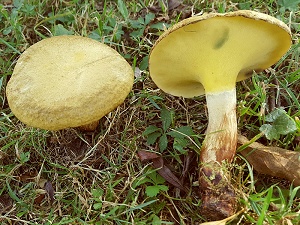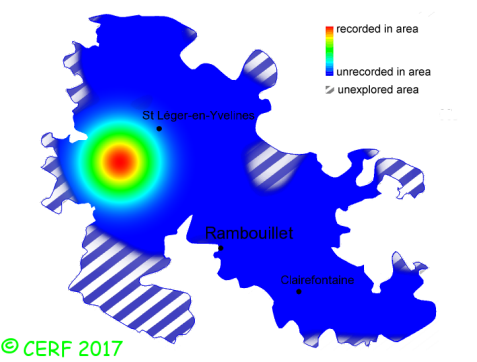| Gyrodon lividus (Bull.:Fr.) Fr. |
|
|
|
|
|
|
The cap is straw-coloured, or ochre to brown, with rusty shades, tuning brown when pressed, not very thick, convex then flattened to depressed. The cap surface is thick, shiny and non sticky when dry, becoming slimy in damp weather (especially in the youth). It is entirely peelable. The cap margin is thin, slightly exceeding. The stem is full and sturdy, cylindrical or slightly spindle-shaped, very thin and with a pointy base. It is often sinuate and sometimes off-centred, covered with longitudinal fibrils. It is concolorous to the cap or paler, more vinaceous brown with age towards the base, and blackish in manipulated areas. The mycelium appearing at the base of the stem is reddish-brown.. The flesh is cream to pale yellow, firm at first then soft-spongy when ageing. It turns to green-blue slightly when cut and exposed to air depending on the humidity level (especially above the tubes), then becomes reddish-brown in the stem base; its taste is not distinctive to mild or slightly acidic; the odour is weak (slightly fruity); The tubes are decurrent, very short (2-5mm), removable from cap although adhering to it, lemon yellow then golden yellow, olivaceous when mature, turning blue or green or brown when cut. The pores are large when mature (0,5-1mm), angular, turning dark grey blue when pressed, then turning brown in bruises. The spore print is olive brown. It grows in very damps areas like marshlands, swamps, stream banks etc., in small groups, solitary or with a few specimens fused at the base, and more often on high ground than at sea level, on a rather calcareous and sometimes acid soil, most of the time with alder. The fruiting period takes place from July to November.
Chemical tests : no reaction to ammonia. Distinctive features : short and yellow, decurrent tubes; yellow pores, turning blue when pressed; flesh turning blue when exposed to air; very narrow stem; straw-yellow to pale brown cap; in association with alder, in wet areas Gyrodon lividus is rare and confined in the forest of Rambouillet, and is quite rare, more generally speaking . | ||
|
page updated on 14/01/18

